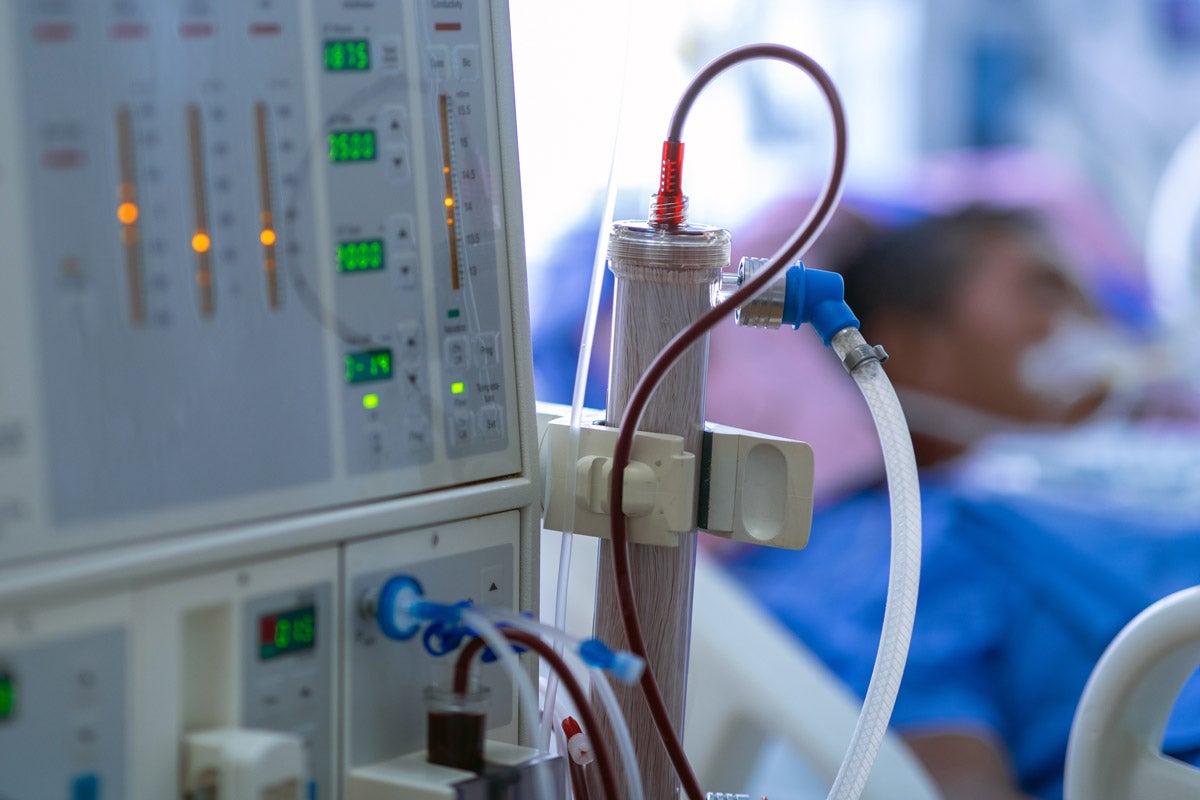
Essay
How we treat alcohol-related liver disease is unfair—it’s time for change
I met Michael during a medical school rotation at a veterans hospital in early 2021. He had alcohol-related hepatitis, a severe, acute inflammation of the liver caused by excessive alcohol use. Nearly half of patients with this condition die within six months of diagnosis.
Michael (not his real name) had been in the hospital for over a week after his liver started failing, causing severe jaundice, confusion (due to hepatic encephalopathy—a nervous system disorder affecting the brain brought on by liver disease), and damage to his kidneys.
Our team had been working to contain the widespread damage caused by Michael’s failing liver, but we were running out of options. We knew his condition could deteriorate rapidly at any time. Treatment options for alcohol-related hepatitis are few, except for one that almost always works but is rarely used: a liver transplant. I brought up the possibility of a transplant for Michael to my team, and learned that his frequent relapses to drinking alcohol despite attempts to stop disqualified him from being considered for a transplant. We didn’t even bother referring him for an evaluation. Michael died less than two weeks later at 45 years old.
Sign up for Harvard Public Health
Delivered to your inbox weekly.
Michael’s story is not unique. In 2020, the National Survey on Drug Use and Health found that 28.3 million Americans suffered from alcohol use disorder, nearly twice as many as any other form of substance use disorder. Alcohol misuse leads to as many as 140,000 deaths in the United States each year. The COVID-19 pandemic has only made the problem worse. Some studies that show more people are drinking more often, and alcohol-related deaths increased by 25% in 2020. Alcohol-related liver disease is a severe and growing problem. To prevent deaths, we must invest in better disease prevention and treatment. That includes changing the rules around who gets a liver transplant, and integrating addiction treatment into comprehensive transplant care.
Recently, alcohol-related liver disease became the leading indication for a liver transplant in the U.S. Until about 2015, hepatitis C was the reason most people were referred for a liver transplant. Improved treatment for hepatitis C has prevented many patients from progressing to liver failure and now, the majority of patients in need of a new liver suffer from alcohol use disorder. Liver disease caused by alcohol includes hepatitis (acute inflammation of the liver from heavy drinking, usually over many years) and cirrhosis (gradual scarring from alcohol use that leads to progressively deteriorating liver function). Both types of liver disease are life threatening and both can be cured by a liver transplant. But livers are scarce—only half of patients put on the transplant list eventually receive one. And there are many more who never even make it onto the waiting list.
Alcohol misuse leads to as many as 140,000 deaths in the United States each year. The COVID-19 pandemic has only made the problem worse.
Despite evidence that early liver transplant dramatically improves survival rates, many providers are still reluctant to do it. Their hesitancy stems from beliefs that alcohol use disorder is inherently unpredictable, inevitably leads to relapse, and “wastes” a liver. Their fears are not unfounded, but they are limiting. The answer lies in adopting a better approach to managing alcohol use disorder—both to prevent the development of liver disease in the first place, and improve health outcomes for patients who do progress to liver disease and need a transplant.
First, we must change the eligibility rules for transplant. There are some transplant centers leading the charge in adopting more flexible criteria for patients in need of liver transplants, but many are still lagging behind. Part of the problem is that accreditation of liver transplant centers is directly tied to patient outcomes, which encourages programs to be more selective in who they list for transplant.
To be eligible for a transplant, patients with alcohol-related liver disease must stop drinking entirely for at least six months, commonly referred to as the “6-month rule.” While some centers have moved away from these rules, many still require some period of mandated abstinence. Patients must also prove they will be compliant with addiction treatment and demonstrate significant social support. All of these criteria can be unrealistic for patients, and here’s why.
The strict rules surrounding liver transplants are in place to select patients who are unlikely to start drinking again post-transplant, as a return to heavy drinking risks severe damage to a transplanted liver. A mandatory abstinence waiting period is used to weed out people who cannot remain abstinent. The assumption is that people who continue to drink despite severe harms to their health during this period will continue to do so after surgery. What these rules miss is that relapses to alcohol use and harmful drinking are defining criteria of alcohol use disorder in the DSM-V. Additionally, studies show the “6-month rule” has questionable value in predicting overall post-transplant health outcomes.
The lack of evidence supporting the “6-month rule” is particularly concerning as many patients with alcohol-related liver disease, especially hepatitis, will die before meeting the required abstinence period. That being said, it is important for patients to eliminate their alcohol consumption to ensure they have good, long-term outcomes from a liver transplant. However, an arbitrary period of abstinence shouldn’t be a prerequisite for transplant eligibility, and a relapse shouldn’t automatically disqualify a patient from getting a liver transplant.
Mandatory abstinence periods are just one of the many issues that patients with alcohol-related liver disease must contend with when pursuing a liver transplant. In an upcoming paper in Liver Transplantation, my colleagues and I re-envision the transplant process to provide more equitable, effective care for these patients.
The lack of evidence supporting the “6-month rule” is particularly concerning as many patients with alcohol-related liver disease, especially hepatitis, will die before meeting the required abstinence period.
The selective nature of transplant eligibility incentivizes patients to censor details about their alcohol use, which can harm their chances of getting adequate treatment for their drinking, and ultimately deny them a new liver. I’ve seen it happen.
Last year, I cared for a woman, Sarah (not her real name), who had also been diagnosed with acute alcohol-related hepatitis but with a much shorter history of liver disease than Michael. When we began evaluating her for a liver transplant, she said she’d been abstinent from alcohol since she first learned of the damage it had already caused to her liver a month earlier. Feeling she would likely be a good candidate for early liver transplant, we eagerly moved forward with our evaluation only to find out through a blood test that Sarah had likely still been drinking since her last medical visit. She was eventually denied access to the transplant waiting list and died within a few days. She was just over 50 years old.
While it is important to get information from patients that helps select candidates for liver transplant who will have good outcomes, it is also important to set reasonable expectations for patients, and establish open and honest communication regarding an individual’s alcohol use.
Clinicians also need to recognize that the existing rules mean decisions around liver transplants are often biased against people living in poverty. High-income patients are better able to demonstrate social support and have better access to treatment for alcohol use disorder. One study found that transplant providers still listed “social support” as an important criteria for determining transplant eligibility for patients, despite knowing that people with higher socio-economic status are better able to demonstrate adequate social support. In addition, a number of studies have shown that Black patients are less likely to make it onto the transplant list than their white counterparts.
These studies highlight the consequences of using overly restrictive criteria when selecting patients for transplant. Patients with more financial and social capital are better able to navigate the complexities of the transplant evaluation process and overcome barriers, while patients from disadvantaged backgrounds struggle.
Despite all our efforts to select patients with the lowest risk of post-transplant complications, at least one in five patients will still return to alcohol use after surgery. We have to deal honestly with the realities of alcohol use disorder as we look to the future of liver transplantation.
We must acknowledge the growing prevalence of alcohol-related liver disease and better integrate addiction treatment within transplant centers. Transplant providers could learn a lot from the principles of harm reduction, which are becoming more common in the field of addiction medicine.
The first principle of harm reduction “accepts that for better or worse…drug use is a part of our world and chooses to minimize its harmful effects rather than simply ignore or condemn them.” In relation to alcohol use disorder and liver disease, this means that instead of requiring total abstinence from alcohol and providing little support to treat the underlying substance use disorder, doctors should work with patients on setting realistic expectations around the possibility of relapse following transplant, and discussing strategies to make sure that these relapses do not become life-threatening. Not all alcohol use following transplant leads to bad outcomes. By developing trust with patients like Michael and Sarah, we could detect alcohol relapse early, and intervene to meet the needs of these patients.
The system currently in place selects candidates using strict, sometimes unsupported criteria that introduce racial and class bias. We can and should work to ensure all patients succeed following transplant, regardless of their race, socio-economic status, or type of liver disease. In doing so, we will create a better, more equitable environment for patients with alcohol-related liver disease, and be better stewards of a scarce resource—transplantable livers.
Top image: Image Source / iStock


